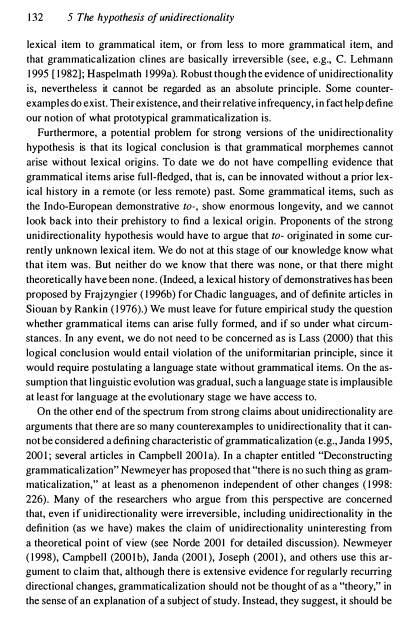Gram - SEAS
Gram - SEAS
Gram - SEAS
You also want an ePaper? Increase the reach of your titles
YUMPU automatically turns print PDFs into web optimized ePapers that Google loves.
132 5 The hypothesis of unidirectionality<br />
lexical item to grammatical item, or from less to more grammatical item, and<br />
that grammaticalization clines are basically irreversible (see, e.g., C. Lehmann<br />
1995 [1982]; Haspelmath I 999a). Robust though the evidence of unidirectionality<br />
is, nevertheless it cannot be regarded as an absolute principle. Some counterexamples<br />
do exist. Their existence, and their relative infrequency, in fact help define<br />
our notion of what prototypical grammaticalization is.<br />
Furthermore, a potential problem for strong versions of the unidirectionality<br />
hypothesis is that its logical conclusion is that grammatical morphemes cannot<br />
arise without lexical origins. To date we do not have compelling evidence that<br />
grammatical items arise full-fledged, that is, can be innovated without a prior lexical<br />
history in a remote (or less remote) past. Some grammatical items, such as<br />
the Indo-European demonstrative 10-, show enormous longevity, and we cannot<br />
look back into their prehistory to find a lexical origin. Proponents of the strong<br />
unidirectionality hypothesis would have to argue that 10- originated in some currently<br />
unknown lexical item. We do not at this stage of our knowledge know what<br />
that item was. But neither do we know that there was none, or that there might<br />
theoretically have been none. (Indeed, a lexical history of demonstratives has been<br />
proposed by Frajzyngier (1996b) for Chadic languages, and of definite articles in<br />
Siouan by Rankin (1976).) We must leave for future empirical study the question<br />
whether grammatical items can arise fully formed, and if so under what circumstances.<br />
In any event, we do not need to be concerned as is Lass (2000) that this<br />
logical conclusion would entail violation of the uniformitarian principle, since it<br />
would require postulating a language state without grammatical items. On the assumption<br />
that linguistic evolution was gradual, such a language state is implausible<br />
at least for language at the evolutionary stage we have access to.<br />
On the other end of the spectrum from strong claims about unidirectionality are<br />
arguments that there are so many counterexamples to unidirectionality that it cannot<br />
be considered a defining characteristic of grammaticalization (e.g., Janda 1995,<br />
2001; several articles in Campbell 200 1a). In a chapter entitled "Deconstructing<br />
grammaticalization" Newmeyer has proposed that "there is no such thing as grammaticalization,"<br />
at least as a phenomenon independent of other changes (1998:<br />
226). Many of the researchers who argue from this perspective are concerned<br />
that, even ifunidirectionality were irreversible, including unidirectionality in the<br />
definition (as we have) makes the claim of unidirectionality uninteresting from<br />
a theoretical point of view (see Norde 2001 for detailed discussion). Newmeyer<br />
(1998), Campbell (200Ib), Janda (2001), Joseph (2001), and others use this argument<br />
to claim that, although there is extensive evidence for regularly recurring<br />
directional changes, grammaticalization should not be thought of as a "theory," in<br />
the sense of an explanation of a subject of study. Instead, they suggest, it should be
















